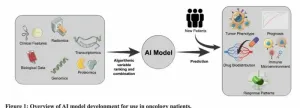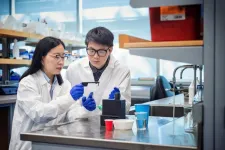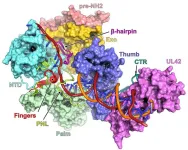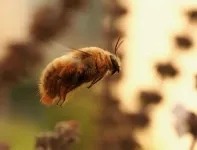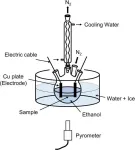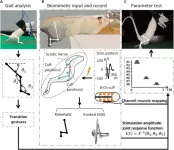(Press-News.org)
“Properly leveraged AI-based techniques could herald a new era of precision medicine guided by non-invasive, imaging-based disease evaluation."
BUFFALO, NY- August 27, 2024 – A new editorial was published in Oncotarget's Volume 15 on August 26, 2024, entitled, “Artificial intelligence: A transformative tool in precision oncology.”
Artificial intelligence (AI) is revolutionizing society and healthcare, opening new possibilities for precision medicine. In oncology, immunotherapy (IO) has similarly transformed cancer treatment with novel therapeutic mechanisms, but it has also introduced atypical response patterns that challenge traditional evaluation methods.
In this editorial, researchers Jeremy McGale, Matthew J. Liao, Egesta Lopci, Aurélien Marabelle, and Laurent Dercle from the Department of Radiology at Columbia University in New York, explore AI's role in addressing these challenges. They focus on the development of new biomarkers for precise disease characterization, particularly those using imaging for the early response assessment of cancer patients treated with IO.
Additionally, the researchers highlight a comprehensive review that applied AI/radiomics to cross-sectional imaging (PET, CT, MRI) showcasing the current landscape in IO treatment. They also determined that of 87 relevant studies, most utilized algorithms to predict treatment response or prognosticate survival at predetermined time points.
“In conclusion, although AI/Radiomics in IO is a rapidly advancing field, there remains significant room for improvement.”
Continue reading: DOI: https://doi.org/10.18632/oncotarget.28639
Correspondence to: Jeremy McGale - jm4782@cumc.columbia.edu, and Laurent Dercle - ld2752@cumc.columbia.edu
Video short: https://www.youtube.com/watch?v=FyZVKeUaUOs
Keywords: immunotherapy, oncology, artificial intelligence, radiomics; lactate, dehydrogenase, PET, MRI, CT, SPECT
Click here to sign up for free Altmetric alerts about this article.
About Oncotarget:
Oncotarget (a primarily oncology-focused, peer-reviewed, open access journal) aims to maximize research impact through insightful peer-review; eliminate borders between specialties by linking different fields of oncology, cancer research and biomedical sciences; and foster application of basic and clinical science.
Oncotarget is indexed and archived by PubMed/Medline, PubMed Central, Scopus, EMBASE, META (Chan Zuckerberg Initiative) (2018-2022), and Dimensions (Digital Science).
To learn more about Oncotarget, visit Oncotarget.com and connect with us on social media:
X
Facebook
YouTube
Instagram
LinkedIn
Pinterest
Spotify, and available wherever you listen to podcasts
Click here to subscribe to Oncotarget publication updates.
For media inquiries, please contact media@impactjournals.com.
Oncotarget Journal Office
6666 East Quaker St., Suite 1
Orchard Park, NY 14127
Phone: 1-800-922-0957 (option 2)
END
Micro- and nanoplastics are in our food, water and the air we breathe. They are showing up in our bodies, from testicles to brain matter.
Now, University of British Columbia researchers have developed a low-cost, portable tool to accurately measure plastic released from everyday sources like disposable cups and water bottles.
The device, paired with an app, uses fluorescent labeling to detect plastic particles ranging from 50 nanometres to 10 microns in size – too small to be detected by the naked eye – and delivers results in minutes.
The method and findings are detailed in ACS Sensors.
“The breakdown of larger plastic pieces into microplastics ...
About The Study: White patients discharged from the emergency department with a nonspecific diagnosis of interest were significantly more likely than Black patients to receive related diagnostic testing in this study. The extent to which this represents diagnostic test overuse in white patients vs undertesting and missed diagnoses in Black patients deserves further study.
Corresponding Author: To contact the corresponding author, Michael I. Ellenbogen, M.D., email mellenb6@jhmi.edu.
To access the embargoed study: Visit our For The Media website at this link https://media.jamanetwork.com/
(doi:10.1001/jamanetworkopen.2024.30306)
Editor’s ...
Two groundbreaking studies published in the journal Cell shed light on the assembly, function and evolutionary diversity of the chloroplast protein import system.
Chloroplasts are fundamental organelles in plant cells that act as the primary site of photosynthesis to sustain life on Earth. Although chloroplasts have their own genome, most of their proteins are encoded in the nucleus and synthesized as preproteins in the cytosol. These preproteins are subsequently transported across the outer and inner envelope membranes of the chloroplasts. The translocon machineries, known as the TOC (translocon at the outer chloroplast membrane) and TIC (translocon at ...
All organisms — from fungi to mammals — have the capacity to evolve and adapt to their environments. But viruses are master shapeshifters with an ability to mutate greater than any other organism. As a result, they can evade treatments or acquire resistance to once-effective antiviral medications.
Working with herpes simplex virus (HSV), a new study led by Harvard Medical School researchers sheds light on one of the ways in which the virus becomes resistant to treatment, a problem that could be particularly ...
Whether you’re strolling through a garden, wandering a park, or simply enjoying an open space in the United States, you’re likely to notice bees buzzing about the flowers. While honeybees, imported from Europe in the 17th century to produce honey, are the most recognizable, they aren’t the only bees at work. If you’re a keen observer, you might spot some of the thousands of less familiar, native bee species that call these spaces home.
Native wild bees play a crucial ecological role, ensuring the survival and reproduction of ...
Single-walled carbon nanotubes (SWCNTs) are known for their remarkable properties, which make them essential in many advanced technologies. Yet, creating these nanotubes efficiently and on a large scale has been a persistent challenge.
Now, a team led by Professor Takahiro Maruyama at Meijo University has introduced a revolutionary method that utilizes cobalt (Co) and iridium (Ir) nanoparticle catalysts in a liquid-phase synthesis process. This innovative approach offers a promising solution to the longstanding issues of production efficiency and scalability. These findings have been published ...
Study led by UCSF estimates 3 to 5% of women have unplanned pregnancies following “permanent” sterilization
Tubal sterilization is thought to be a permanent form of birth control and is the most common method of contraception nationally. But a new study led by UC San Francisco reports that tubal surgery fails often enough that some other forms of birth control are usually more effective.
The authors found that 3 to 5% of women in the United States who had their tubes tied later reported an unplanned pregnancy. This failure rate led the authors to suggest that patients who really want to avoid future pregnancy should instead ...
New York, NY (August 27, 2024) – The National Institute of Diabetes and Digestive and Kidney Diseases (NIDDK) Catalyst Award program has awarded a $4 million, five-year grant to Prashant Rajbhandari, PhD, Assistant Professor of Medicine (Endocrinology, Diabetes and Bone Disease) at the Mount Sinai Diabetes, Obesity, and Metabolism Institute, to investigate a new frontier in understanding metabolic diseases like obesity and type 2 diabetes.
While much is known about how organs like the liver, fat tissue, and ...
LOUISVILLE, Ky. – The University of Louisville’s groundbreaking Green Heart Louisville Project has found that people living in neighborhoods where the number of trees and shrubs was more than doubled showed lower levels of a blood marker of inflammation than those living outside the planted areas. General inflammation is an important risk indicator for heart disease and other chronic diseases.
The Christina Lee Brown Envirome Institute launched the first-of-its-kind project in 2018 in partnership with The Nature ...
A research paper by scientists at Beijing Institute of Technology presented a sciatic nerve stimulation method that will aid in lower extremity standing and stepping.
The new research paper, published on Jul. 04 in the journal Cyborg and Bionic Systems, used the electrical nerve stimulation method and achieved muscle control via different sciatic nerve branches to facilitate the regulation of lower limb movements during stepping and standing.
Peripheral nerve stimulation is an effective neuromodulation method in patients with lower extremity movement disorders caused by stroke, spinal cord injury, or other diseases. ...
